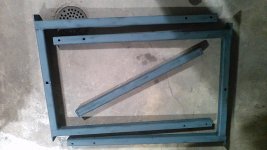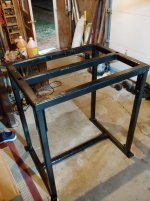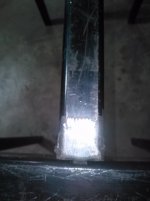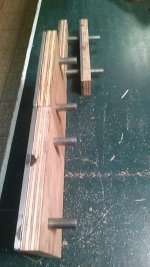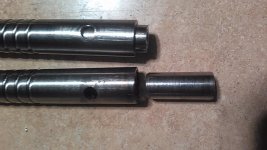Randalthor
Cast Iron
- Joined
- Mar 7, 2018
- Location
- Kansas City
Background:
I have an employee who is a relative, that has been strength training for lots of years. He is like a son to me.
He's into arm wrestling. And I would like to build him a regulation arm wrestling table.
The problem to solve is that he needs a portable table with removable legs from the top, but once the table is set up, the removable legs (and table) need to be very rigid.
In other words the legs need to be detachable (so it's portable) but once fastened, the legs and table need to be very stable. These men put a lot of torque on the table. Wobbly legs (which translate to wobbly table) won't cut it.
It's no problem to build the top super strong. That's easy. But I'd love to hear some ideas on building removable legs which are rigid once installed. Ideally, installation of the legs wouldn't require an engineer to install. Rather a very minimal amount of time and minimal ease.
In tournaments, the bottoms of the table legs are bolted to the floor. That's easy enough to do, but for the portable table I'd like to build, I'd like the removable legs rigid when fastened to the top, yet removable.
I'd appreciate any ideas to fasten removable legs to the top of the table. Again the legs need to be removable, yet when fastened, very rigid.
I'm a proficient welder with a mig and industrial stick welder. I also have a Bridgeprort mill. I'm really looking for the best rigid removable legs, with the equipment I have
Here is a vid of a table. The example vid was taken at a tournament about 3 weeks ago in the United Arab Emirates. As an FYI, it's a vid of one of the best up and coming arm wrestlers called Schoolboy (because he looks like a schoolboy). He is wrestling one of the most powerful power lifters alive (Larry Wheels). Larry Wheels holds many world records in power lifting. Nevertheless, Schoolboy dominates him in these matches. But the table is what I'd like to build, yet portable and rigid, with removable legs.
SCHOOLBOY VS LARRY WHEELS | ARM WRESTLING SUPER MATCH 2021 - YouTube
I have an employee who is a relative, that has been strength training for lots of years. He is like a son to me.
He's into arm wrestling. And I would like to build him a regulation arm wrestling table.
The problem to solve is that he needs a portable table with removable legs from the top, but once the table is set up, the removable legs (and table) need to be very rigid.
In other words the legs need to be detachable (so it's portable) but once fastened, the legs and table need to be very stable. These men put a lot of torque on the table. Wobbly legs (which translate to wobbly table) won't cut it.
It's no problem to build the top super strong. That's easy. But I'd love to hear some ideas on building removable legs which are rigid once installed. Ideally, installation of the legs wouldn't require an engineer to install. Rather a very minimal amount of time and minimal ease.
In tournaments, the bottoms of the table legs are bolted to the floor. That's easy enough to do, but for the portable table I'd like to build, I'd like the removable legs rigid when fastened to the top, yet removable.
I'd appreciate any ideas to fasten removable legs to the top of the table. Again the legs need to be removable, yet when fastened, very rigid.
I'm a proficient welder with a mig and industrial stick welder. I also have a Bridgeprort mill. I'm really looking for the best rigid removable legs, with the equipment I have
Here is a vid of a table. The example vid was taken at a tournament about 3 weeks ago in the United Arab Emirates. As an FYI, it's a vid of one of the best up and coming arm wrestlers called Schoolboy (because he looks like a schoolboy). He is wrestling one of the most powerful power lifters alive (Larry Wheels). Larry Wheels holds many world records in power lifting. Nevertheless, Schoolboy dominates him in these matches. But the table is what I'd like to build, yet portable and rigid, with removable legs.
SCHOOLBOY VS LARRY WHEELS | ARM WRESTLING SUPER MATCH 2021 - YouTube



